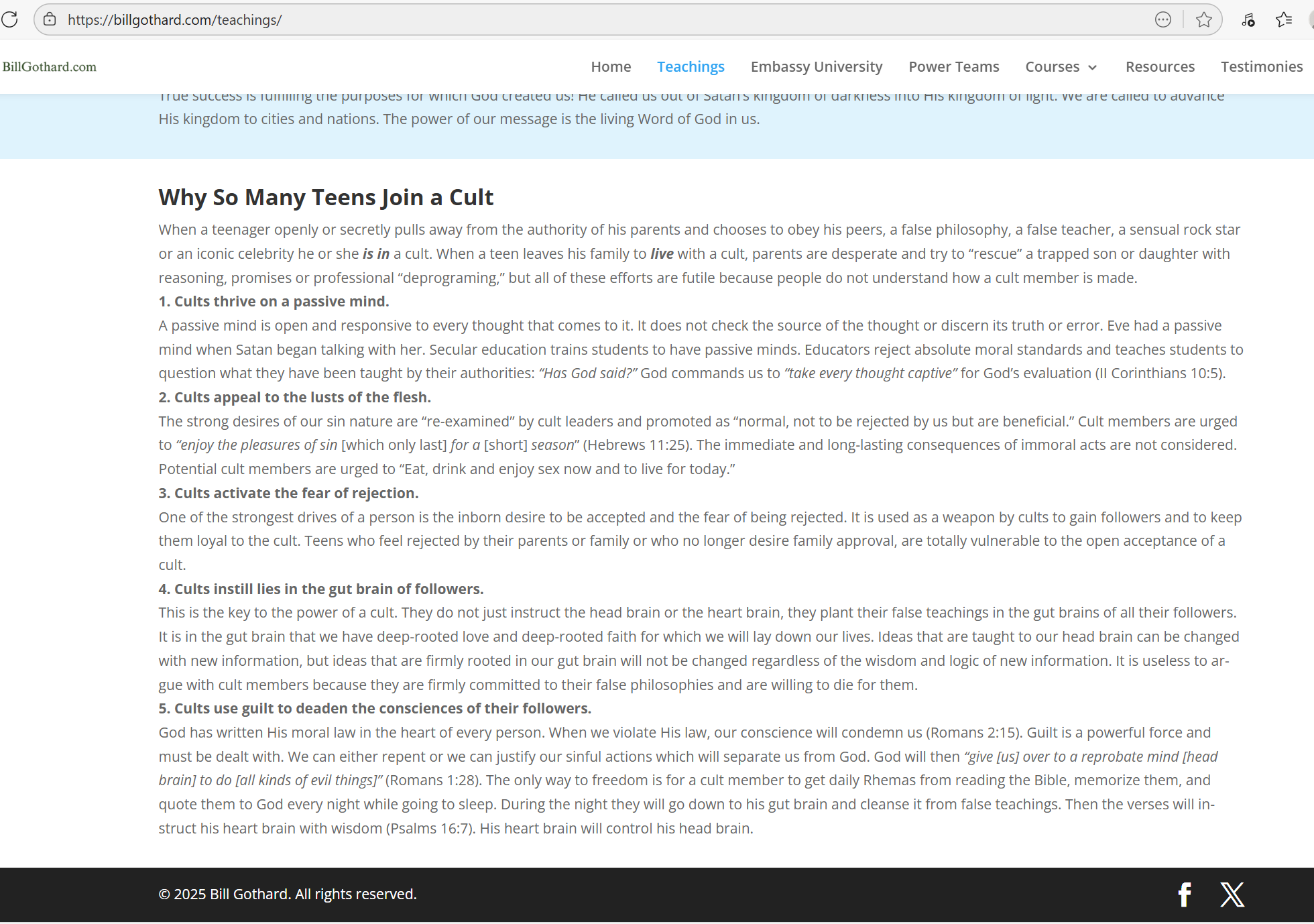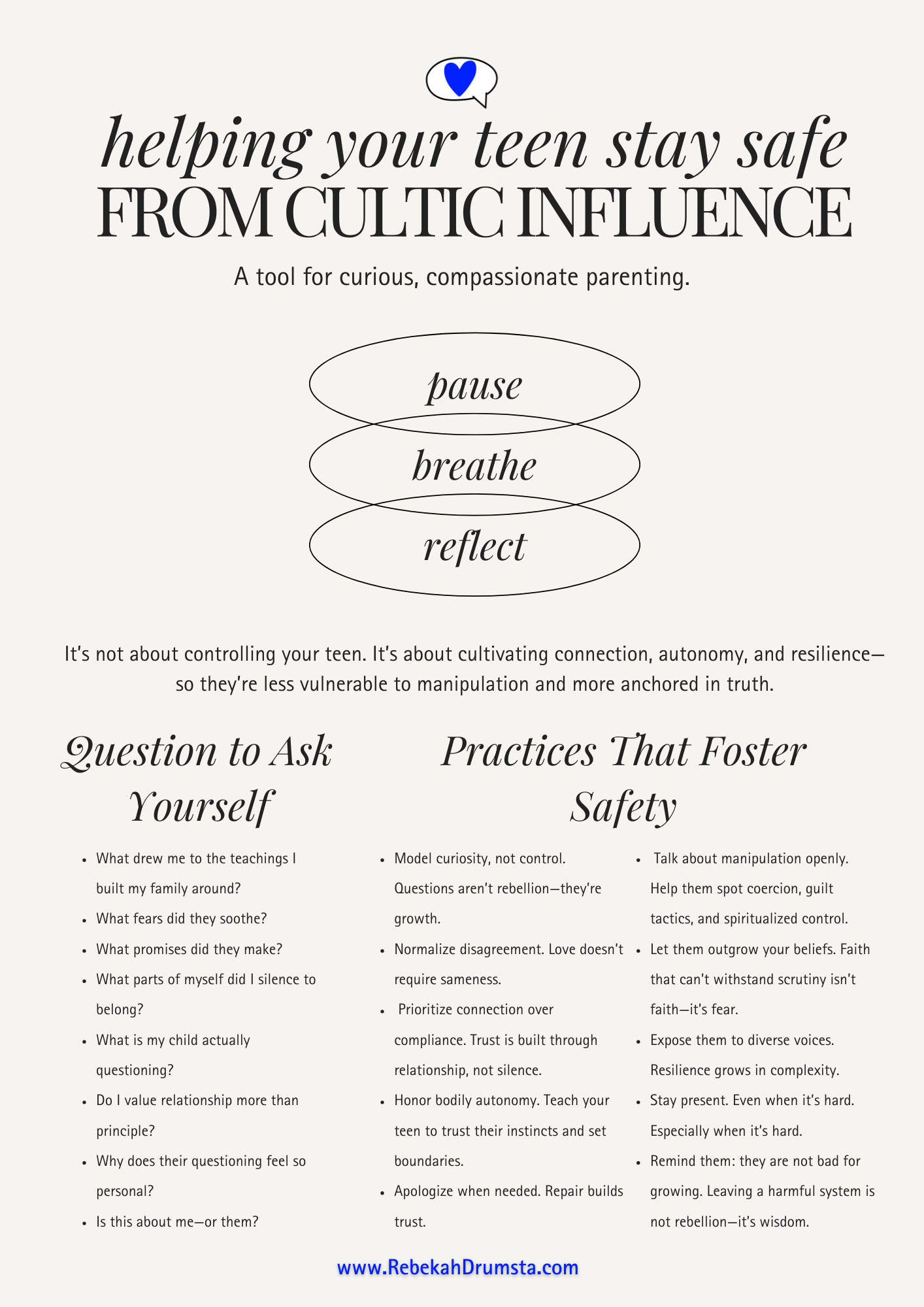When the Cult Is the One Writing About Cults
A Survivor’s Response to “Why So Many Teens Join a Cult” by Bill Gothard with a Tool That Could Really Help Your Teen Stay Safe From Cultic Influence
This week I was researching a topic for another article I was developing and of all things, Bill Gothard’s own website pulled up. I have never chosen to view his site. I wasn’t in a place that hearing his voice again was safe for me. But this week, was different. Imagine my shock when I discovered a section entitled, “Why So Many Teens Join a Cult.” Of course…I read it.
As I scanned Bill Gothard’s article on his own website about why teens “join a cult,” I didn’t just see flawed logic—I saw a mirror. Not of the teens he describes, but of the system he built. A system I survived.
This isn’t some takedown for sport. It’s a reckoning. Because when the architect of a high-control religious movement accuses teens of cult-like behavior for questioning authority, we need to pause and ask: whose definition of “cult” are we using?
Let us first walk through his claims—one by one.
Screenshot from Bill Gothard’s website - 10.13.25
1. “Cults thrive on a passive mind.”
Gothard says secular education creates passive minds. But in his own seminars, critical thinking was discouraged. Questions were reframed as rebellion. Discernment was replaced with obedience. We were taught to “take every thought captive”—but only if it aligned with his interpretation of Scripture.
A passive mind isn’t formed by asking questions. It’s formed by being punished for asking them.
In trauma-informed spaces, we recognize that autonomy, including intellectual autonomy, is essential to healing. When children are taught to suppress their instincts, override their intuition, and distrust their own discernment, they become vulnerable—not to secularism, but to control.
Systems that demand unquestioned loyalty don’t foster wisdom. They foster fear. And fear, not curiosity, is what makes a mind vulnerable to manipulation.
2. “Cults appeal to the lusts of the flesh.”
This one’s a classic purity culture move: equate autonomy with immorality. Gothard paints teens who seek joy, connection, or bodily agency as seduced by sin. But let’s be honest—his teachings on sexuality were steeped in shame, control, and fear. Survivors weren’t taught to honor their bodies; we were taught to distrust them.
When you teach that pleasure is dangerous and curiosity is sinful, you don’t protect teens—you isolate them. And isolation is a hallmark of cultic systems. It’s not the pursuit of life-giving, pure joy that leads to harm—it’s the suppression of it. Bodily autonomy is not rebellion.
Isolation is fertile ground for exploitation. The problem isn’t that teens are exploring their humanity. The problem is when they’ve been taught that their humanity is inherently corrupt and evil.
3. “Cults activate the fear of rejection.”
Yes, fear of rejection is powerful. But in Gothard’s world, acceptance was conditional. Love was earned through compliance. Teens who questioned authority weren’t embraced—they were labeled rebellious, bitter, or spiritually deceived.
If fear of rejection makes someone vulnerable to a cult, then conditional love is the cult’s favorite tool.
In healthy systems, love is not transactional. It does not hinge on obedience or silence. When children are taught that belonging requires self-erasure, they learn to perform rather than connect. And when they finally step away from that performance, it’s not because they’ve been seduced—it’s because they’re seeking truth.
Healthy relationships make space for complexity, disagreement, and growth. When belonging is tied to obedience, it’s not love—it’s control.
4. “Cults instill lies in the gut brain.”
Gothard’s gut-brain concept is likely part of his “three brains”—head brain, heart brain, and gut brain – philosophy. Maybe it’s neuroscience language coated in Scripture? I am unsure, but it appears he claims cults bypass logic and embed lies in the gut. But what happens when a leader uses spiritual language to embed fear, shame, and unquestioned loyalty into the deepest parts of a child’s identity?
The most dangerous lies aren’t taught by outsiders. They’re whispered by trusted voices who claim to speak for God.
Survivors of high-control religious systems often do describe a visceral, embodied trauma—one that lives not just in memories, also instinct and “muscle memory.” And when that harm is reinforced through repetition, isolation, and spiritual threat, they don’t just shape beliefs—they shape identity. Undoing that harm requires more than logic. It requires safety, truth-telling, and the restoration of agency.
5. “Cults use guilt to deaden the conscience.”
This one hits hard because guilt and fear wear the currency of Gothard’s teachings. We were told that questioning authority, setting boundaries, or naming harm meant we had a “reprobate mind.” Repentance wasn’t about healing—it was about submission.
When guilt is weaponized to silence survivors, it’s not conviction—it’s control.
Trauma-informed frameworks recognize that guilt, when distorted, becomes a tool of manipulation. True healing invites accountability, not shame. It honors the complexity of harm and the dignity of those who name it.
You see, there’s a difference between accountability and shame. One invites repair. The other demands erasure. And when guilt is used to suppress truth, it doesn’t cleanse the conscience—it fractures it.
But What About the Parents?
Gothard’s article is framed as a warning to parents: your teen might be joining a cult. But what if the teen—or adult child—isn’t joining one at all? What if they’re trying to grow up and think for themselves?
What if that so-called “rebellion” is actually a reclamation of self? What if the “programming” is a desperate attempt to restore autonomy, not destroy it?
It’s easy to fixate on what the child is doing. But what if we turned the lens inward for a moment? What if the question isn’t “What’s wrong with them?” but “What shaped us?”
As a mom of a teenager, I know the feeling: the heat rising in a hard conversation, the regret over how I responded, the ache of watching my child wrestle with something I can’t fix. But if I’ve learned anything in my decades on this planet, it’s this—there’s always more beneath the surface.
Instead of rushing to correct, defend, or diagnose, what if we got curious?
Curious about our parenting. Curious about our beliefs. Curious about the systems we trusted to guide us.
Because in the end: Our children get to decide if we were good parents. Not us.
Many parents were doing their best with the tools they were given. But some of those tools were forged in fear, not freedom. And when a child begins to question, it’s not a threat—it’s a sign of resilience.
So here’s a tender invitation:
Are we healthy?
Are our beliefs flexible enough to make room for growth or change? Are our relationships strong enough to hold disagreement? Are our hearts open enough to hear pain without rushing to defend?
Your child’s spiritual pain is not a threat to your legacy. It’s an invitation to healing. You don’t have to protect the system. You can choose to protect the connection.
Currently raising kids or teenagers and want support? I’ve created a brief reflective tool for parents, Helping Your Teen Stay Safe From Cultic Influence: A tool for curious, compassionate parenting. You can download the PDF version here.
Side note: Very few teenagers registered themselves for Gothard’s Institute in Basic Life Principles or Advanced Training Institute programs. It was their parents who joined the program. That matters as teens, in Gothard’s opinion, were the ones full of struggle and mistakes. (IBLP was originally IBYC – Institute in Basic Youth Conflicts.)
Final Thoughts
I don’t write this to be cruel or vindictive. I write this because I’ve lived it. I’ve seen what happens when spiritual language is used to justify emotional manipulation. I’ve walked the long road of disentangling faith from fear.
So when Gothard warns parents about teens joining cults, I want to gently suggest: maybe the teens aren’t joining one. Maybe they are trying to leave one.
This article is not intended to treat or diagnose any condition.
Rebekah is not a licensed therapist or clinician. Any advice or opinions given on this site are strictly her own observation and insights based on personal experiences and study. It should in no way take the place of professional assistance.



